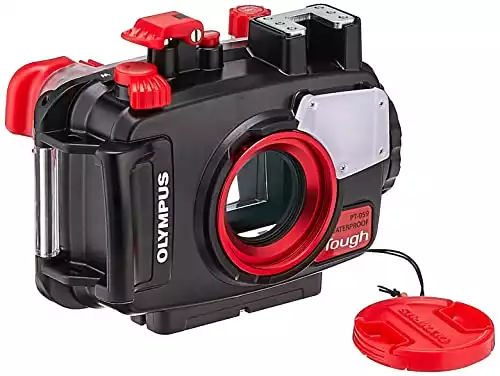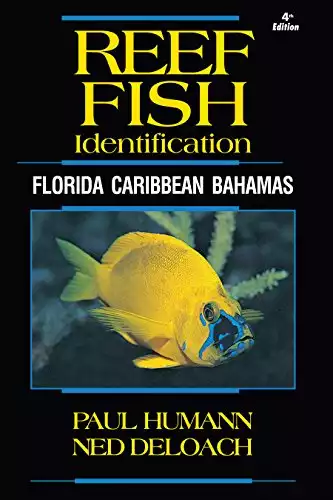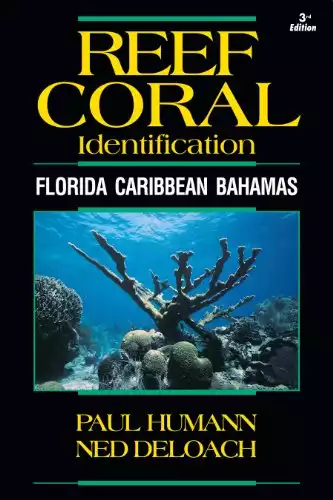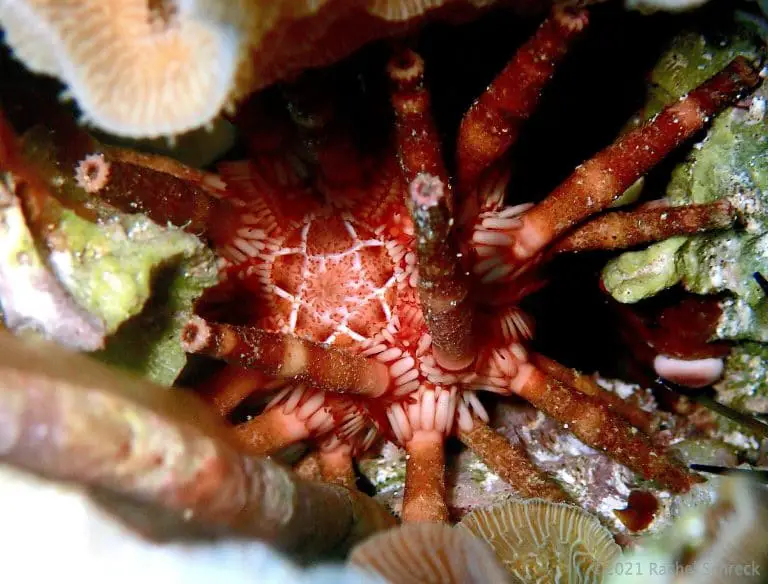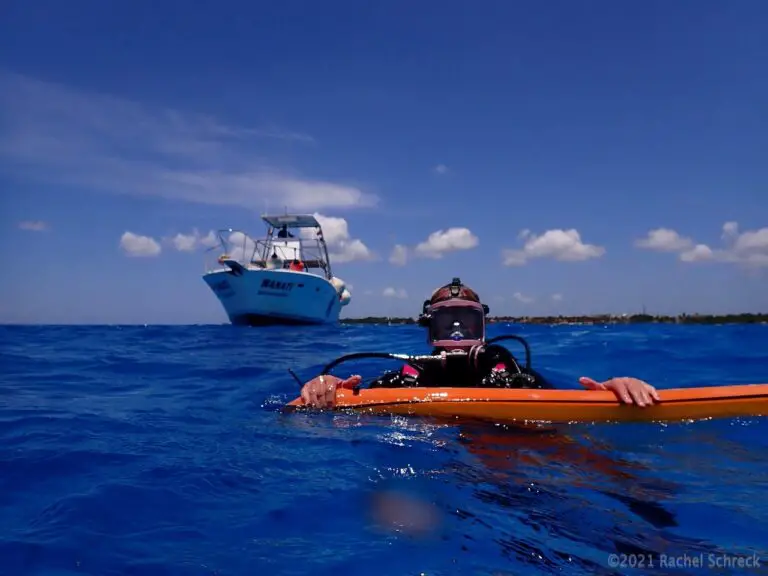Cozumel Marine Life – Camouflage Critters
I just learned a new term while researching this post: cryptic coloration.
That’s another way to say “camouflage” which I – like many divers – find endlessly fascinating.
Especially when you see it truly in the flesh, while scuba diving in Cozumel, or in another high-quality scuba diving destination.
As a diver, you can witness lots of examples of cryptic coloration among marine life, especially coral reef dwellers and fish or invertebrates that inhabit the ocean’s sandy floor.
Cryptic Coloration Underwater in Cozumel
Camouflage can be used by many different types of organisms including birds, reptiles, amphibians, insects, and even mammals, like the sea otter.
Underwater, many of the biodiverse species living in or near coral reefs also use adaptive camouflage for survival.
Common marine animals that have cryptic coloration include fish, crustaceans, mollusks, echinoderms, and cephalopods like the awesome octopus.
Marine biologists have studied how these creatures are able to disguise themselves in order to avoid being seen – and eaten – by other species.
Changing color can also be used among underwater animals as a means of communication, as in when a large fish or shark is ready to be cleaned by a smaller fish. The barracuda, for example, may alter its color to indicate it will not harm various small cleaner fish or shrimp during that time.
Some marine animals may change color when ready to attract a mate, or when on a different kind of hunt – for prey.
Camouflage Critters in Cozumel
The various means of camouflage by marine animals are some of my favorite phenomena to witness and photograph when scuba diving in Cozumel – or anywhere, for that matter.
Here are a handful of common Caribbean marine species that rely on cryptic coloration to survive, so be on the lookout for these animals when you’re scuba diving in Cozumel.
Read on for a primer on best examples of camouflaged Cozumel marine species:
Octopus in Cozumel Blend Right In
Probably the most celebrated underwater creature with an incredible set of camouflaging abilities is the octopus, a cephalopod.
When scuba diving in Cozumel, we mainly see the Caribbean reef octopus (Octopus briareus), and typically only at night, during one of our awesome night dives.
However, you can get lucky and spot a Caribbean octopus out on the reef during the day on any one of the dive sites, or at least hiding in various cracks and crevasses.
Cozumel octopi frequently live inside hiding spots in coral reefs where they feed on small invertebrates like crabs, various types of cleaner shrimp, jellyfish, tube and fan worms, etc. Octopuses also eat mollusks, like scallops, clams, and snails.
Cephalopod skin has an amazing ability to change colors quickly, thanks to cells called chromatophores.
Many thousands of color-changing cells called chromatophores just below the surface of the skin are responsible for these remarkable transformations. The center of each chromatophore contains an elastic sac full of pigment, rather like a tiny balloon, which may be colored black, brown, orange, red or yellow.
Smithsonian Institute’s Ocean Life website
Not only are their cryptic coloration skills amazing to see in real-time, but they also have the added abilities of shape-shifting, and sometimes can even mimic the textures, carriage, and behaviors of their backgrounds and other species.
When diving in Cozumel, you can watch an octopus moving across the coral reef, and witness its colors morph into the surrounding rocks and coral, and it essentially disappears into its environment, before your very eyes.
The most common time to see octopus here is after the sun goes down, namely when diving at night.
On Cozumel night dives, using artificial lights to see the animals’ skin color (when it is calm and not in fight or flight mode), divers can witness the brilliant aqua blue-green color of our most common local octopus population.
There is always a chance to see them during the day, as well, though that’s when they are typically hiding.

Even if they’re not hiding in a cave or fully blended with the reef, they still blend in quite well most of the time and easily use their cryptic coloring to meld with the surrounding rocks and corals.
OR they might just try to grab the first hiding spot they can, like this funny little guy I recently found! He was hiding in a nice round sponge, suspended off the side of the Santa Rosa shallows reef at about 45 feet. It wasn’t such a quality hiding place, but I almost missed him!
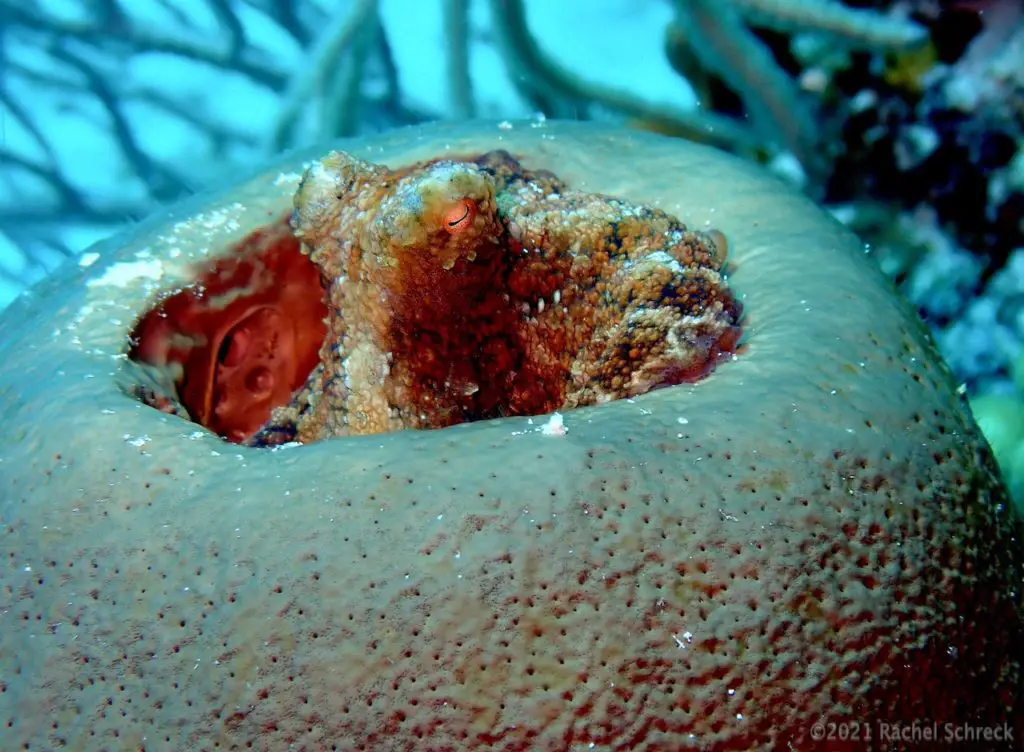
Scorpionfish
The scorpionfish is another of my favorites among Cozumel’s cool marine animals that do a great job of blending into its surroundings.
Often you will pass by a good-sized scorpionfish embedded in among coral heads, rocks, or even seagrass, and not notice it until you get closer – or indeed pass it by in the current.
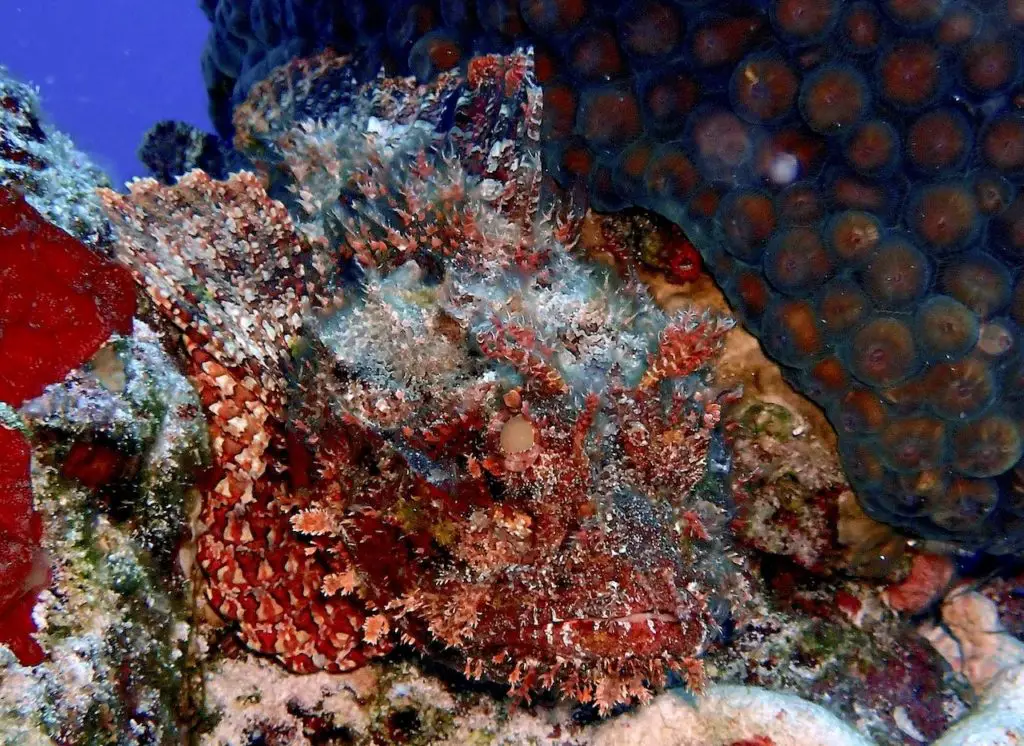
The scorpionfish will often look similar to a rock covered in algae. Thanks to its largely sedentary behavior as a cryptically colored ambush predator, a scorpionfish may in fact allow algae to grow on itself, creating a deceptively welcoming place for small fish and other organisms to seek shelter.
Scorpionfish then use their large jaws to open extremely quickly – mere milliseconds – creating a strong vacuum effect that sucks in its targeted prey into its mouth in a flash.
When the scorpionfish itself feels threatened, it may use another related tool of coloration by suddenly opening and “flashing” the skin inside its fins to display a much more flamboyant set of colors and spots. This flash of color warns predators that the scorpionfish has the capacity to deliver a venomous sting with its dorsal spines.
Regarding scorpionfish and human scuba divers, not seeing one could potentially be dangerous.
Human injuries are rare, but sometimes divers or snorkelers may accidentally step on or otherwise brush up against a camouflaging scorpionfish, which causes the fish to strike with its venom-filled spines – very similar to a lionfish puncture wound and sting, combo. Youch.
When diving in Cozumel, try to avoid this at all costs – for both of your sakes.
According to Divers Alert Network’s (DAN) handbook on hazardous marine life, this process is called “envenomation.” Scorpionfish venom could cause serious complications and should be treated and monitored, but most often the result is a small but nasty wound, accompanied by great stinging pain for several hours, swelling for a day or two, and probably bruising for a few days.
Peacock Flounders
Flounders are another common group of Cozumel bottom-dwelling fish that utilize color changes to survive.
Peacock flounders are the main type, and when diving in Cozumel you can see a range of them, from teeny juvenile flounders in the sand, up to large ones that are resting in seagrass beds, on the coral reef itself, or using their sandy-colored cryptic coloration to mimic the sandy ocean floor.
It’s often difficult to spot these fish at first because of their natural camouflage.
Flounders on the ocean floor – especially the juveniles of the species – are almost invisible against the sand, and sometimes the best way you find them is if you happened to catch one moving out of the corner of your eye.
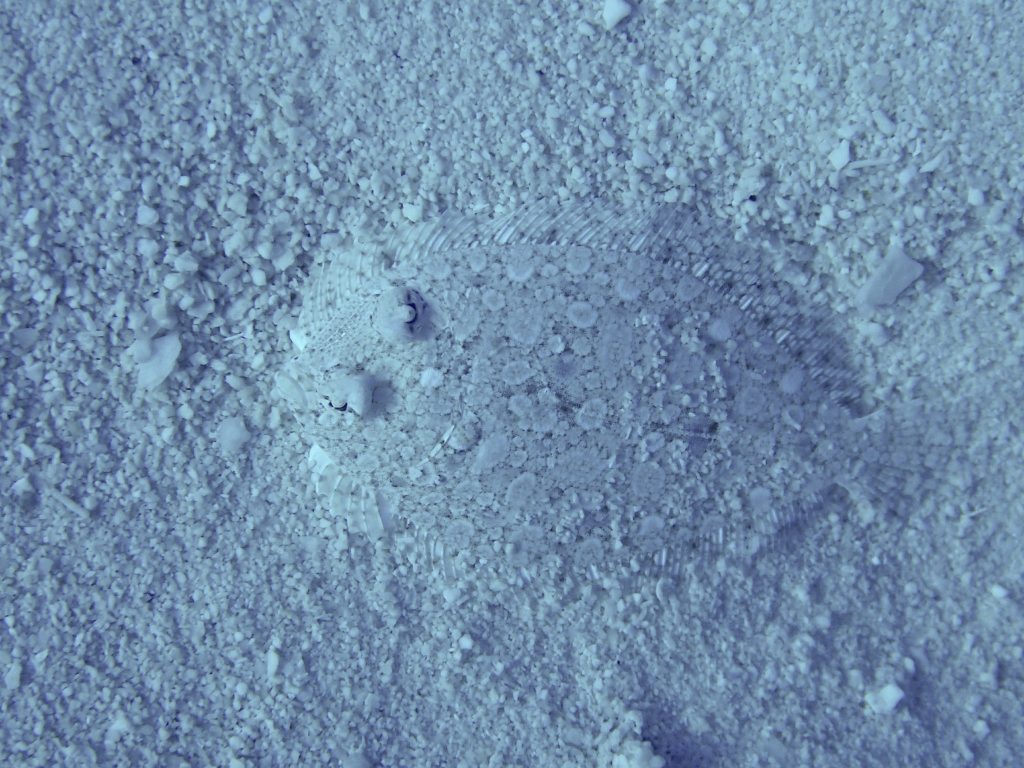
It doesn’t help that the very young juvenile flounder are tiny – in the case above, for example, only about a half-inch / 2cm in length.
But don’t give up! I never found them myself at first, but the more you dive and see them, the more you’ll spot on your own.
Once you start getting the hang of spotting Cozumel’s flounder fish, you might catch sight of one quicking darting along the sand, or notice a break in the sand pattern, only to recognize the fish’s eyes or the notched edges of its dorsal, anal and pelvic fins.
Note: 99.9% of the underwater shots on this site were taken by yours truly with a simple 2 piece set-up from Olympus. Done. For full notes on my easy but quality UW photo gear to get you started, see more at the end of this post.
Trumpetfish
Trumpetfish are fun and frequent fish to see while diving in Cozumel, and while I always seemed to see them around long fronds of sea whips or gorgonian corals, I didn’t quite get that they were camouflaging at first.
According to Lamar University’s marine biology department profile of trumpetfish, this tendency to hide and hover among corals is due to them being poor swimmers.
This allows them to hide from potential predators, and also gives them more of a chance to find a good snack.
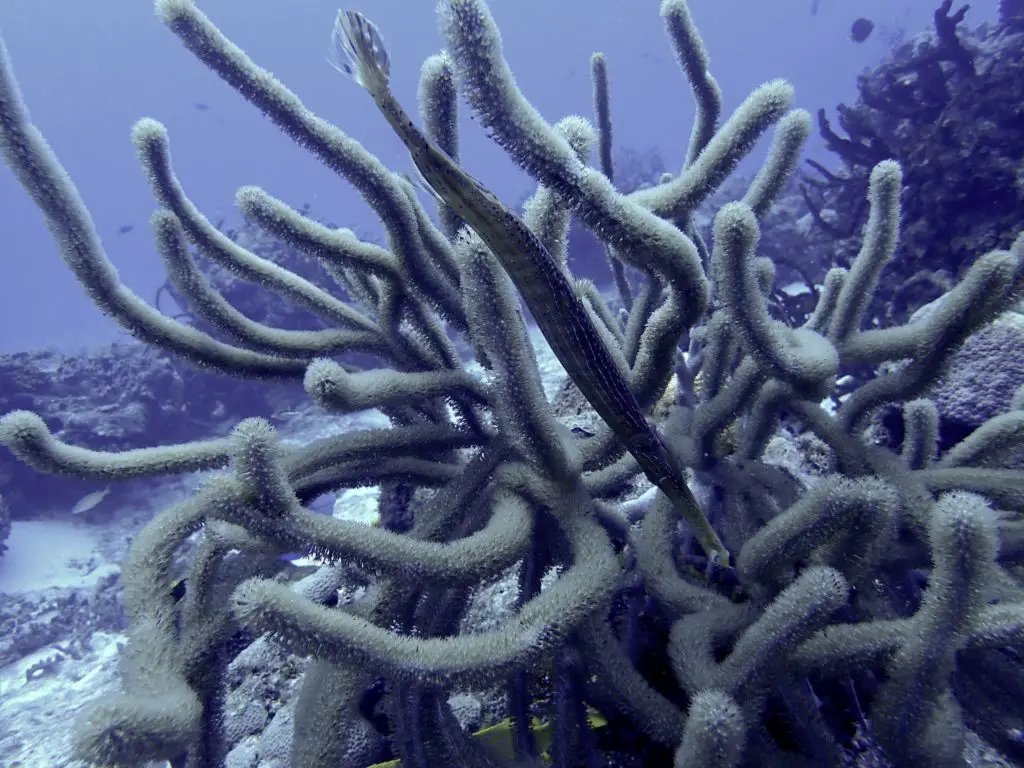
Trumpetfish have pigment-filled chromatophore cells (like the octopus’ mentioned above) so they change color to blend in with a particular scenery they’re in. Trumpetfish also use mimicry behavior to look like the coral or other structures they hide in (as seen in the image, above).
Juvenile Filefish
Adult filefish are large, with unique long tail fins, and a distinctive shape.
As juveniles, however, filefish are not only very small, but they’re great at blending in with their surroundings – typically various types of gorgonian corals.
The juvenile filefish are tiny little fish and tend to stay hidden within the branches of the corals on the reef, which makes them even harder to spot.
In addition, juvenile filefish mimic the colors and textures of the coral they’re inhabiting, so they blend in skillfully – to the point of almost vanishing.

However, sometimes if you spot one and can maintain good buoyancy control and stay still, you’ll notice them drifting about between the arms of the coral, only to “disappear” again.
This behavior helps keep them safe from larger predatory fish…and often from the prying eyes of underwater photographers.
Juvenile filefish were some of my favorite first underwater macro subjects, despite the initial challenge of spotting them, and then the now ongoing challenge of capturing a nice frame while they seem nonchalantly intent on ducking away and behind the thin branches of a gorgonian coral.
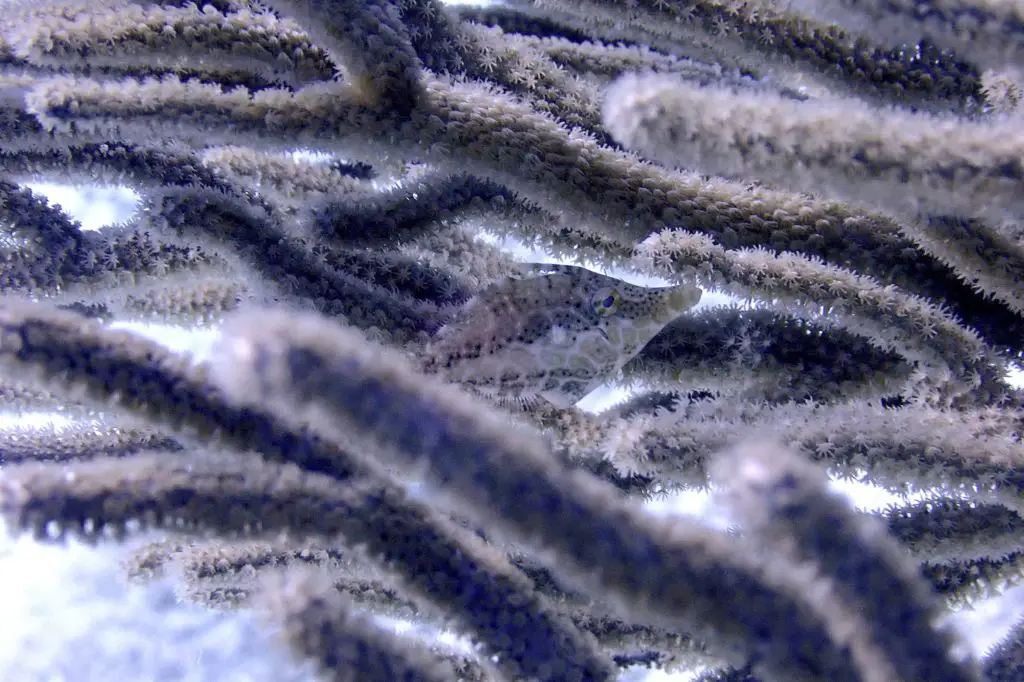
Stingrays
Stingrays seem to use a combination of hiding and blending techniques.
Like sharks, larger southern stingrays seem to be a good example of the type of camouflage known as countershading. Here the ray is dark on the top, so less detectable to predators (or fishermen) from above, while very light on their underside, so bottom-dwelling animals don’t see them coming, as from below they blend into the brightness of the ocean’s surface.
Stingrays also use a simple hiding technique, where they flap their ‘wings’ (a.k.a. pectoral fins) and nestle down into the sand, nearly covering themselves with a thin layer of top sand.
Sometimes, all you can spot are their eyes or spiracles (breath holes) – or from a wider view, the full outline of their impressive size and shape.
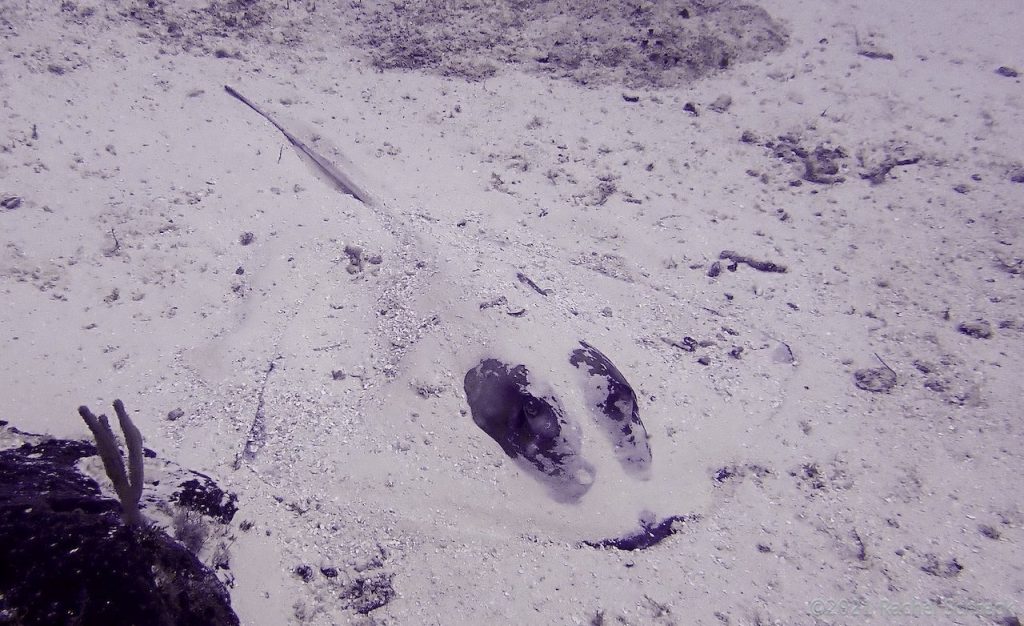
Meanwhile, Cozumel divers will also encounter numerous small yellow stingrays.
Yellow stingrays are only about 1 foot/30cm long and have more elaborate markings, which often make them stand out.
But when you see where they tend to seek shelter or rest, it becomes obvious that those markings actually aid in their need to blend.
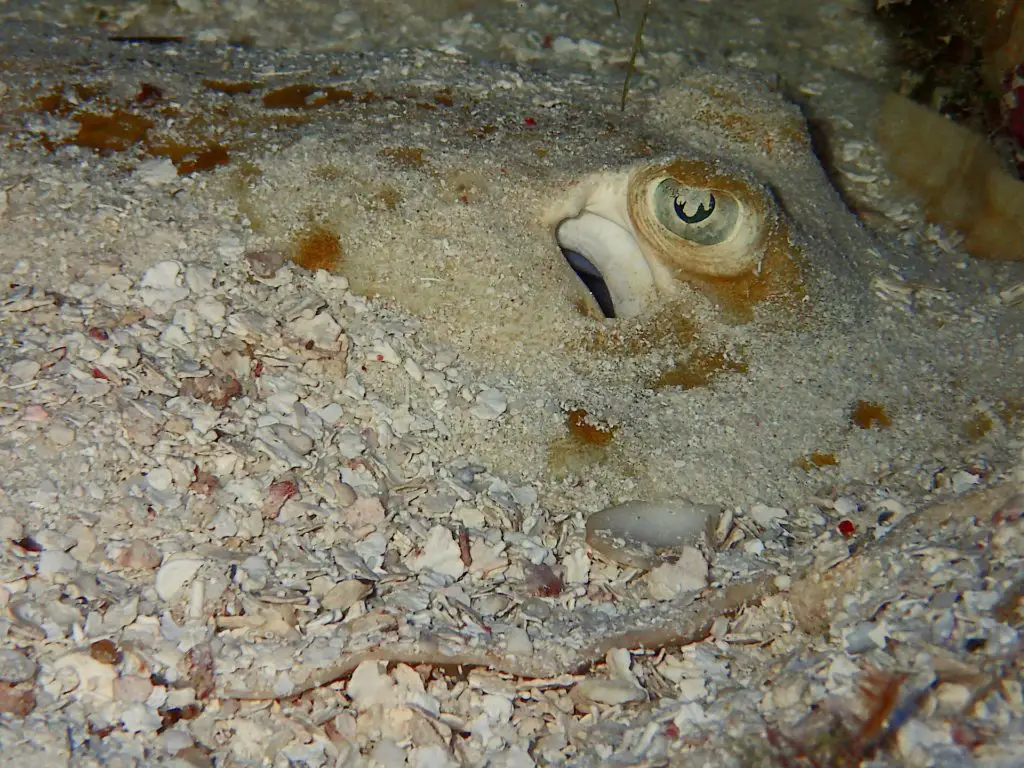
When resting, small yellow stingrays spread their bodies flat on the sandy seabed, sometimes even going farther and burrowing themselves under a light layer of sand to truly cover their bodies.
There have been many times when I was looking at some other marine critter nearby, only to swim right over a stingray that was buried in the sand. Yikes.
Divers should please always be mindful of the many sand-dwelling critters, to avoid that kind of accidental confrontation and more importantly, to respect the full marine habitat, and not disturb the thousands of sand-dwelling critters, large and small.
Lizardfish, a.k.a. Sanddiver
This is a funny little fish that blends in well with its environment.
The lizardfish has an elongated body, and looks very much like a lizard swimming through the seagrasses, and then stopping for prolonged periods to seemingly ‘lay out’ on a sunny rock for a while – much like a local Cozumel gecko or iguana.
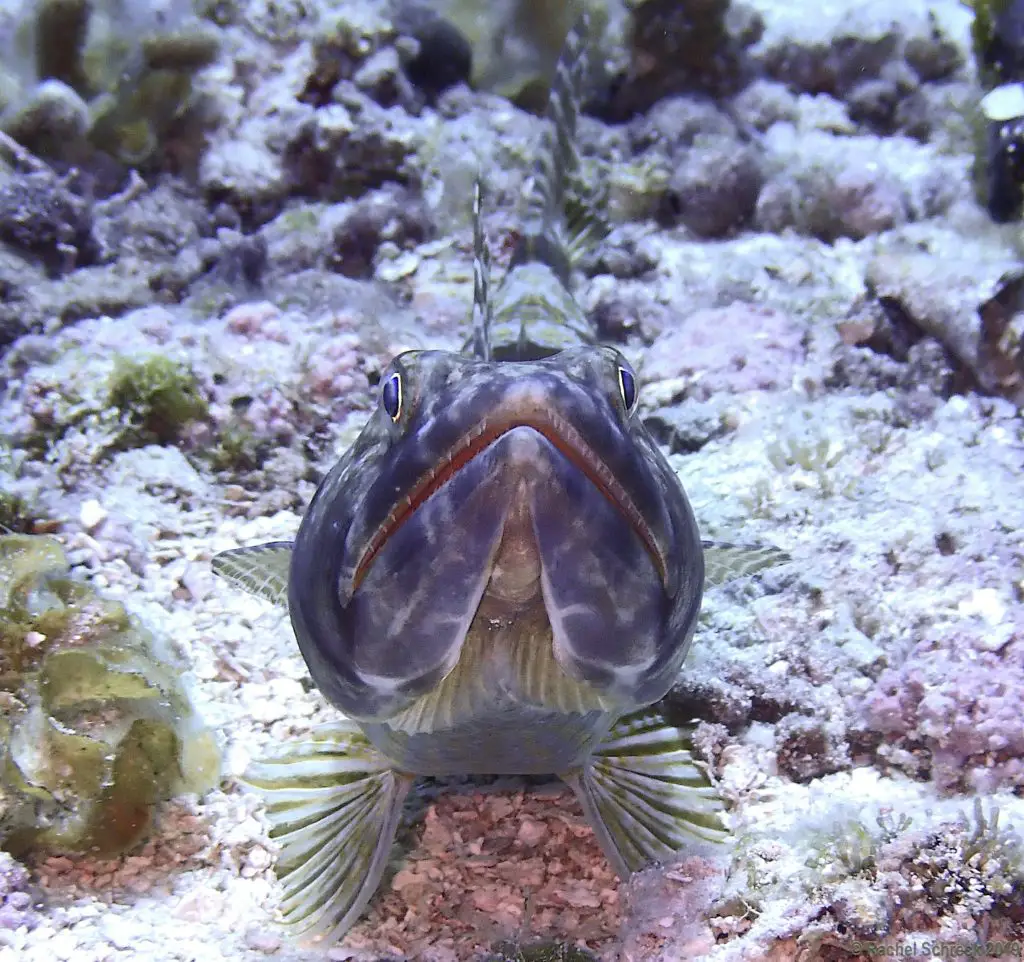
They don’t really seem to do anything else except sit there quietly until someone or something disturbs them.
Then they quickly dart away, leaving just enough time for you to realize what happened before they disappear completely.
From time to time, though, they exhibit an excellent form of marine camouflage.
Also known as sanddivers, lizardfish will bury themselves in the sand, leaving only their face exposed.

Lizardfish are not dangerous, but when you’re not expecting something hiding under the sand like that – and then get to experience their super quick, darting action when approached too closely – it can really startle you.
Nurse Sharks of Cozumel
Like their stingray cousins, above, nurse sharks have natural countershading. This makes them obscured from sight from above, as their darker backs and dorsal fins blend in with the ocean depths and meanwhile are less noticeable to low or bottom-dwelling prey.
Then again, most of the time, nurse sharks in Cozumel are good at just plain hiding under the reef for a daytime nap.
To read and see more about shark encounters in Cozumel, check out this full post on the types of sharks divers often see in Cozumel.
Sea turtles
Turtles are reptiles, a class of animals known for great camouflaging techniques.
When you see a sea turtle in the sand, it’s not immediately obvious that they are indeed working the cryptic coloration.
However, when you see them swimming and feeding among the corals or in grassy areas, you can understand how their coloring provides them with better camo coverage, so they may elude larger predators.

To read all about the island’s local sea turtle populations of loggerhead, hawksbill, and green sea turtles, and where to see them (and help them!), please go next to our full guide to Cozumel sea turtles, here.
So, there you have it. If you’re into marine biology and camouflage, you’ll very likely see the above examples, and more, if you’re scuba diving or snorkeling in Cozumel.
And if you want to get into taking some fun specimen photos like the ones in this article, check out my recommendations for high-quality but simple and inexpensive underwater camera gear, just below.
This relatively inexpensive and easy setup will help you pack light, yet get you going on the right path with
- Easy to use
- Easy to pack
- Easy on the wallet
- Durable, waterproof, dustproof


